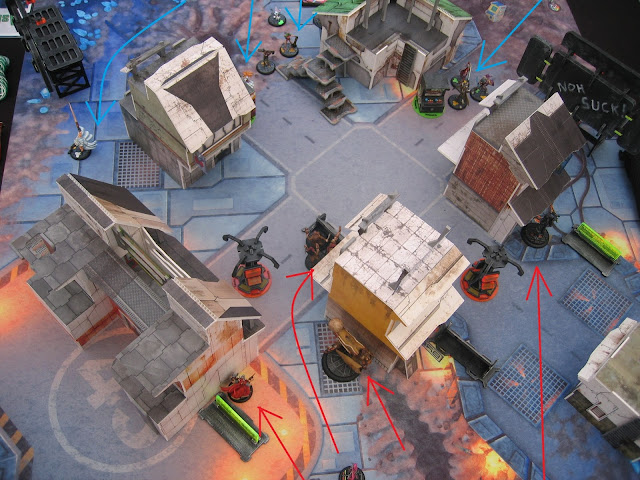Introduction
My very first adult wargaming army was my 15mm Assyrians. In the early 1980s they took on various forces owned by university friends - Saxons, Byzantines, Han Chinese, Carthaginians - using WRG Ancients Rules (5th or 6th edition, if I remember correctly).
I figured that the only way I would be able to field my Assyrians against a contemporary army was if I collected it myself, so I started to build forces for late Hebrews (Judeans), Midianite Arabs and Kushite Egyptians (the black, 25th dynasty). Pretty much all of these could be used as enemies or allies for any of the others.
And that was that. I moved away to take up my first job and suddenly was in a strange town, buying and renovating my first house and didn't have time to play wargames. In any case, my enthusiasm for 1980s-style WRG rules had started to pale...
Roll on several decades and Hail Caesar was published by Warlord Games. It's taken me a few years of wishing, but we finally played our first game of this last Sunday.
Setup
So, nothing too elaborate for our first outing with Hail Caesar. This was to be a straight-up fight between 2 similarly-sized forces, with just a medium-sized town, some gentle hills and a small wood for terrain. The town was divided into 4 sectors, each capable of holding one standard-sized unit.Assyrians
- 2 x mixed infantry divisions
- 1 x light infantry division
- 1 x royal division, entirely cavalry and heavy chariots.
Allies
- 2 x Hebrew divisions, each a mixture of medium and light infantry. King Hezekiah's division also had a couple of heavy chariot units.
- 2 x Midianite Arab divisions, each a mixture of camels, light infantry archers, warbands and skirmishers.
The Game
- An early series of good command rolls saw the Assyrian centre advance unopposed through the town, whilst the nearby Hebrews looked on, bemused.
- Elsewhere, the Assyrians also seized the woods, though only with a very small force.
- On the left flank, King Balaam's Midianites moved forwards swiftly and began to pelt the much larger Assyrian force with missiles.
- First kill of the game went to some Assyrian skirmishers; some shooting and a failed morale roll saw opposing Hebrew skirmishers run away. A small triumph, but still...
- To the extreme right, a number of Midianite camels held up the Assyrian advance for pretty much the entire game, preventing their light infantry from supporting their skirmishers in the woods.
- A determined Hebrew attack saw them gain a foothold in the town...
- ...but another assault was repulsed bloodily, with both sides suffering heavy casualties.
- The Midianites on the left had caused a lot of damage to the opposing infantry, taking only a few casualties in return. Even though they were badly shaken, the Assyrians held their ground; they just wouldn't flee...
- Near the town, the Hebrew mercenary medium infantry clashed with a lone Assyrian unit, but suffered greatly for their bravery.
- An uncontrolled advance saw more Assyrians move deep into the Midianite lines.
- The Assyrian light division and the Midianites on the right flank exchanged many arrows, but neither side seemed prepared to force the issue by charging into melee - at least until very late in the game.
- Finally, King Hezekiah realised that there was nothing much in front of him other than some enemy skirmishers. It took a few turns for his ponderous heavy chariots to catch these Assyrian levies (they kept evading!), but when he did so the outcome was completely predictable: the Hebrew chariots obliterated their foes.
- Seeing that their skirmishers were on the verge of running away, the Assyrians' Royal Division launched a devastating mounted charge against their Midianite enemies, shattering and overrunning infantry and camels alike.
- With other losses from the nearby infantry fights, the Midianite king's division just disintegrated; the few survivors hastened off the field.
- Hebrew infantry pressed on through the town, but the fighting was bloody and they ran out of steam by the time they got to the half-way point.
- Indeed, the Hebrews in the town were so exhausted that even a feeble attack by a tired Assyrian force was enough to destroy one unit. This broke one of the Hebrew divisions, at which point we called it a day.
Winners and Losers
There's no doubt that this game ended in an Assyrian victory. Indeed, they lost very few units - and almost all of those were expendable skirmishers. However, there were not many units left in their army who didn't have a large number of casualties, so it was by no means a pushover!
I think that the crisis came early with the sluggishness of the Hebrew centre. They should have advanced into the empty town easily; the failure to do so put them on the back foot throughout the game. Although they eventually forced their way in the buildings, this was at a great (and ultimately unsustainable) cost.
On the left flank, the Midianite king gallantly held up 2 entire Assyrian divisions pretty much unaided. However, he was too outnumbered and just couldn't convert the early casualties he caused into routing enemy units. Eventually, the counterattack swept him away.
The right flank was a stalemate, with neither side's light forces able to gain any real advantage.
Conclusion
We will certainly play Hail Caesar again! This was a fun game, though the multi-zone built-up area did cause us some confusion about rules. Indeed, I've posted questions about this on the Warlord Games forum to see if anyone can offer a definitive interpretation.
So, our next game will probably not use buildings (or not many, at least!) and will have a more interesting scenario. I'm hoping so, at least!

































